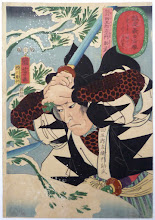Way back last year, Noisms of Monsters and Manuals blogged about the contents of wilderness hexes. He showed through real world examples that even a 1-mile hex can have a lot of adventure opportunity. And most RPG maps are at the 5 or 6 mile hex scale, or 24 mile scale.
So, imagine you've got one of those wilderness maps with all hexes numbered, and keys with something (or several things as Noisms suggests) interesting in each hex.
How do you determine when something is found?
Wandering monster rolls are of course one way. If there's a random encounter while in that hex, instead of rolling a random monster, the encounter could be with whatever monster lairs there (although not necessarily in the lair). This is fairly simple and elegant, as the more times the PCs cross the hex or spend actively searching, the likelier they are to encounter what ever is keyed there.
The down side is that you then no longer have wandering or random encounters when in the wilderness.
Also, the probabilities for wandering monster encounters tend to increase with the more wild the terrain is, at least in Classic D&D. It's been so long since I've looked at AD&D's wilderness encounter charts I don't remember, but I have a feeling it's the same. Anyway, you're more likely to encounter some monster in a swamp or jungle than you are in open plains or the desert.
If the keyed encounter is with a monster tribe or the like, well, that makes sense to keep it this way. But what if the keyed encounter is a location like a ruined temple or some unusual (super)natural feature? Wouldn't it be harder to find in a forest or the mountains that it would be in open fields? Perhaps a new chart with inverted chances of encounters would be in order for such things.
A lost oasis fortress might not be hard to find at all while traveling through a flat rocky desert. The hidden Elven city of Gondollin would be next to impossible to find. Should each encounter have its own chance to be randomly found listed?
That's a lot of checking map keys and rolling dice for each hex that's passed through. I'm sure a computer program could be created to handle all of that, but I sure don't have the time to make one (or the skill, at the moment, although I'd guess the coding for such wouldn't be too hard to learn).
The easiest way to handle things at the table, I guess, would be to treat it in a manner similar to searching for traps or secret doors. If the players are passing some potential encounter, and they say something that would likely put them close, allow them to have the encounter. If not, or they are simply "searching," give them a die roll (would Elves have a bonus to find lost temples or hidden orc cave-lairs?) of some sort.
Or the default method presented in modules, if they pass through the hex they have the encounter, and just don't put stuff in every hex.
On a related note, I had an idea while thinking of all the above. Would there be a desire for a "random wilderness stocking system" similar to the simple random dungeon stocking tables in the Basic Sets? I've been using them with my Megadungeon project, and they're nice for spacing out encounter areas among the rooms, and force me to get creative when there are many traps or specials in certain areas. Something similar for the wilderness might be handy. Maybe I'll try to come up with something some day.
Friday Fantasy: Return of the Green Death
5 hours ago






Consider just adding "keyed encounter" to your random encounter chart. Then, if an encounter is keyed to a location, the creature/thing/lair/whatever is encountered (a subtable may be part of your hexmap key). If there is nothing keyed, treat as "no encounter".
ReplyDeleteThat would make things much simpler. Thanks for the suggestion.
DeleteIt's so easy to get caught up in different ideas like this, and I then miss the simple answers like that.
This comment has been removed by the author.
ReplyDeleteI draw the hex, and then have them move across it with a game piece.
ReplyDeleteOn the Requested Map of Dreams
Do you do that for each hex, or only the "important" ones?
DeleteAll the hexs are important ones.
DeleteIn all seriousness, there are two options. They are either travelling through the hex to a destination (checks per day with wandering monster charts) or they are clearing the hex (itemized list of hex contents) or they are exploring the hex. If it is the last it gets a map.